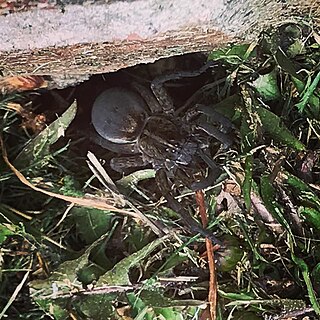
Tigrosa aspersa is a large wolf spider that inhabits the eastern United States. Compared to its close relative Tigrosa helluo, T. aspersa is much larger. This species was known as Hogna aspersa prior to 2012, when it was moved to Tigrosa.

Cornu aspersum, known by the common name garden snail, is a species of land snail in the family Helicidae, which includes some of the most familiar land snails. Of all terrestrial molluscs, this species may well be the most widely known. It was classified under the name Helix aspersa for over two centuries, but the prevailing classification now places it in the genus Cornu.

Alexicles is a monotypic genus of tiger moth genus in the family Erebidae. Its only species, Alexicles aspersa, the Alexicles moth, is found in the US states of New Mexico and Arizona. Both the genus and species were first described by Augustus Radcliffe Grote in 1883.
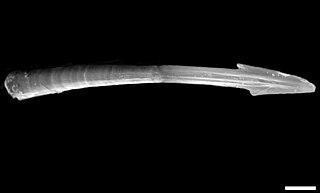
A love dart is a sharp, calcareous or chitinous dart which some hermaphroditic land snails and slugs create. Love darts are both formed and stored internally in a dart sac. These darts are made in sexually mature animals only, and are used as part of the sequence of events during courtship, before actual mating takes place. Darts are quite large compared to the size of the animal: in the case of the semi-slug genus Parmarion, the length of a dart can be up to one fifth that of the semi-slug's foot.
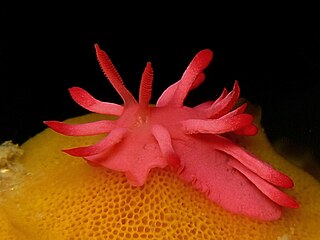
Okenia is a genus of colorful sea slugs, specifically of dorid nudibranchs, marine gastropod mollusks in the family Goniodorididae.
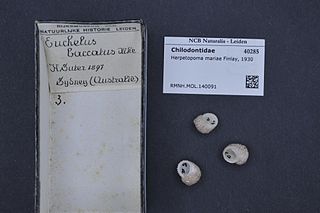
Herpetopoma mariae is a species of marine gastropod mollusc in the family Chilodontidae.

Chromodoris aspersa is a species of colourful sea slug, a dorid nudibranch, a marine gastropod mollusc in the family Chromodorididae.

Helicina aspersa is a species of a land snail, terrestrial gastropod mollusk in the family Helicinidae.
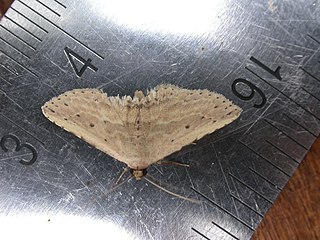
Hyposada aspersa is a species of moth of the family Noctuidae first described by Turner in 1945. It is found in Queensland, Australia.

Ascidiella aspersa, the European sea squirt, is a species of solitary sea squirts native to the northeastern Atlantic, from the Mediterranean Sea to Norway. They possess oval bodies up to 50 to 130 mm in length. Their branchial siphons are conical and positioned at the top of the body. They possess six to eight lobes. The atrial siphons are located at the upper third of the side of the body and possess six lobes. The body is covered by a firm transparent test that is greyish to brown in color. The test often snag detritus that remain loosely attached to the animal. When expanded, at most 40 tentacles can be observed on the inside surface of the branchial wall. Both the openings of the branchial and atrial siphons possess lighter colored ridges on their rims. They may also be frilled at times. A. aspersa are attached to the substrates by the left side of their bodies. They can be found in dense groups of unfused individuals on hard surfaces like rocks. at depths of up to 90 m (300 ft).

Hyperplatys aspersa is a species of longhorn beetles of the subfamily Lamiinae. It was described by Thomas Say in 1824.

Glycymeris aspersa, common name the clothed bittersweet, is a species of saltwater clam, a marine bivalve mollusc in the family Glycymerididae, the bittersweets.
Eilema aspersa is a moth of the subfamily Arctiinae first described by Arthur Gardiner Butler in 1882. It can be found in Madagascar.
Euconosia aspersa is a moth of the subfamily Arctiinae first described by Francis Walker in 1862. It is found on Borneo and Bali. The habitat consists of alluvial forests, including regenerating forests, as well as coastal forests.

Eunidiini is a tribe of longhorn beetles of the subfamily Lamiinae. It was described by Téocchi et al. in 2010.
Okenia aspersa is a species of sea slug, a Dorid nudibranch, a marine gastropod mollusc in the family Goniodorididae.

Eunidia is a genus of longhorn beetles of the subfamily Lamiinae.
Eunidia batesi is a species of beetle in the family Cerambycidae. It was described by Olliff in 1889.
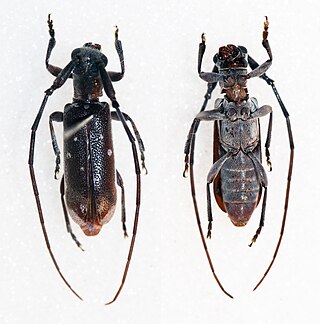
Eunidia thomseni is a species of beetle in the family Cerambycidae. It was described by William Lucas Distant in 1898. It is known from Tanzania, Cameroon, Chad, Niger, Ethiopia, Senegal, Mozambique, Botswana, Namibia, Saudi Arabia, the Central African Republic, Somalia, Uganda, South Africa, Yemen, Kenya, and Zimbabwe.













